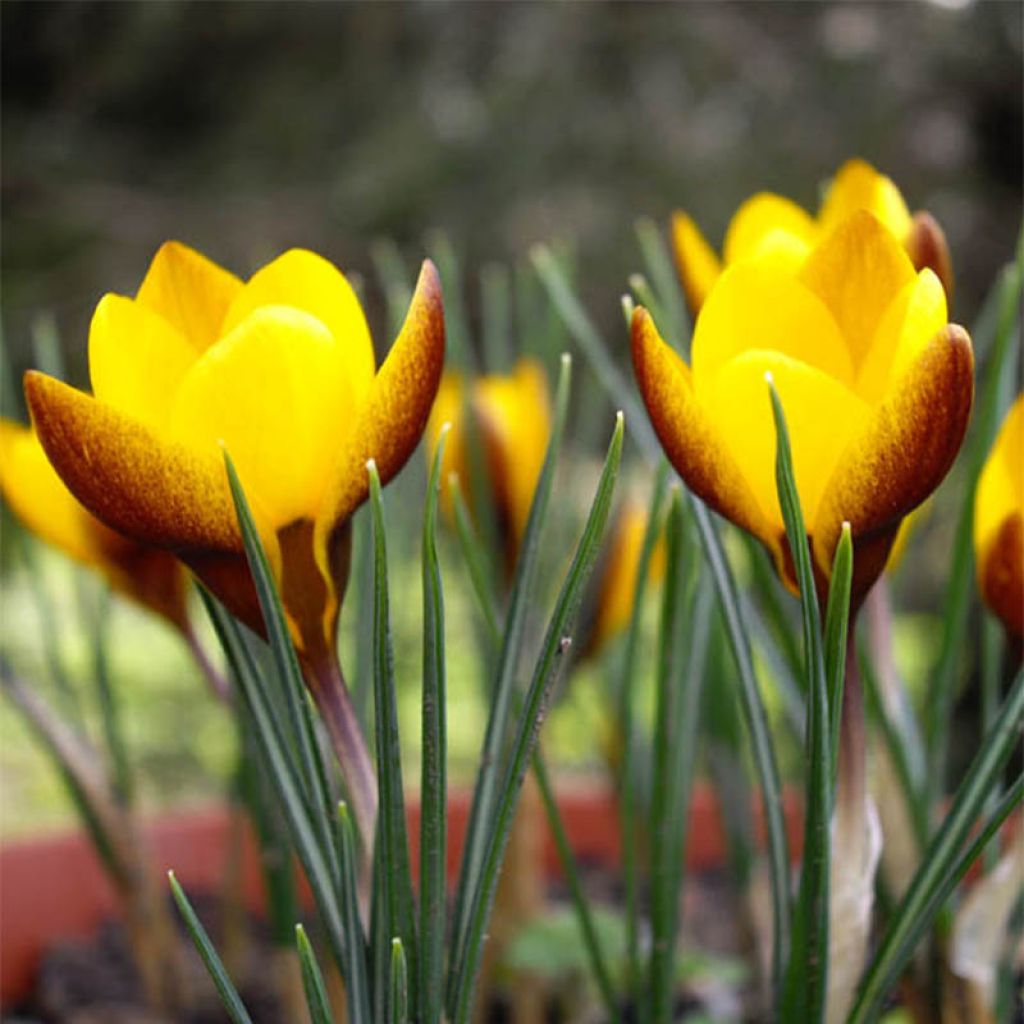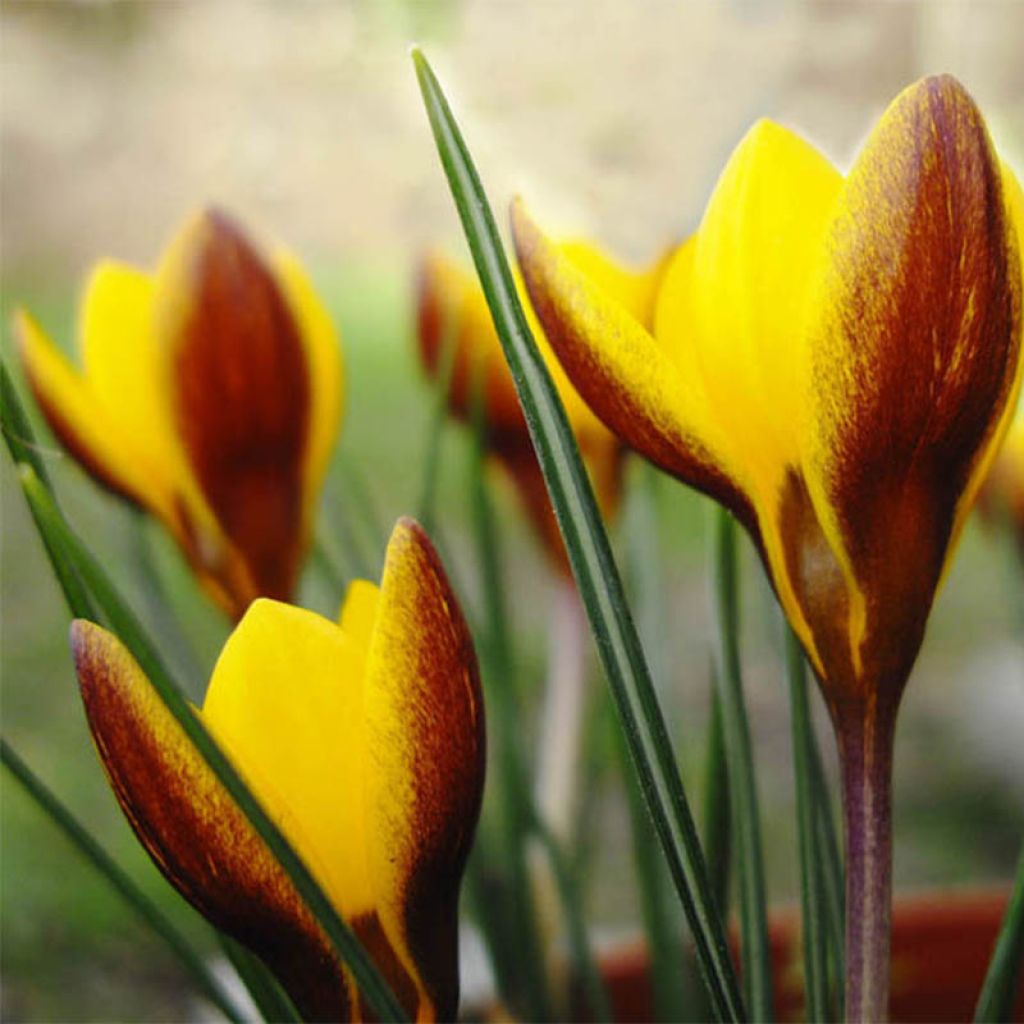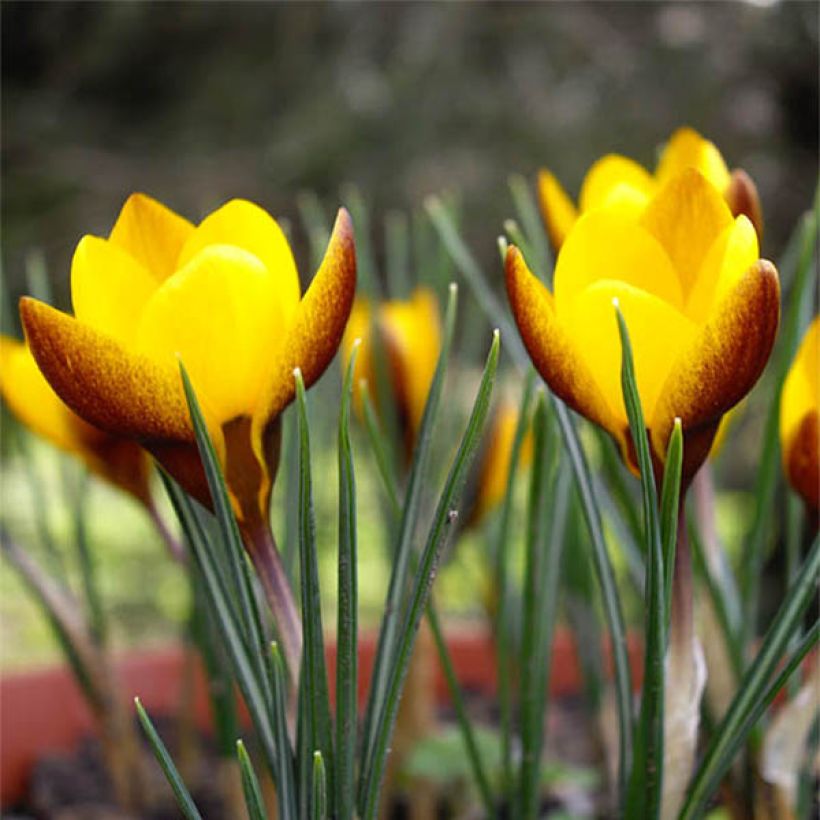

Crocus chrysanthus Zwanenburg Bronze - Crocus doré


Crocus chrysanthus Zwanenburg Bronze - Crocus doré
Crocus chrysanthus Zwanenburg Bronze
Crocus chrysanthus Zwanenburg Bronze
Snow Crocus, Golden Crocus
All the plants from Promesse de Fleurs are of high quality.
mireille O., 11/07/2017
This plant carries a 6 months recovery warranty
More information
We guarantee the quality of our plants for a full growing cycle, and will replace at our expense any plant that fails to recover under normal climatic and planting conditions.
From €5.90 for pickup delivery and €6.90 for home delivery
Express home delivery from €8.90.

Does this plant fit my garden?
Set up your Plantfit profile →
Description
Crocus chrysanthus 'Zwanenburg Bronze' is a superb variety of golden crocus, a vigorous botanical species that is easy to grow. Its bi-coloured flowers are highly fragrant and vividly coloured with deep yellow striped with bronze markings, embellishing fine dark green foliage in late winter. This small bulb blooms with remarkable generosity, faithfully returning each year with dozens of brightly coloured cups in flower beds or rockeries. It thrives in the sun, in well-drained soil.
Crocus chrysanthus 'Zwanenburg Bronze' belongs to the Iridaceae family. Its ancestor, the golden crocus, originates from Turkey and the Balkan Peninsula. 'Zwanenburg Bronze' is a Dutch horticultural hybrid with many qualities that has received the prestigious Award of Garden Merit from the Royal Horticultural Society in England. This prolific plant forms significant colonies in upright clumps measuring 12cm (5in) tall. It has a rapid rate of growth and multiplication. Flowering occurs from February to March, depending on the climate. The plants bear a multitude of cup-shaped flowers that open into stars. The exterior of the corolla is bicoloured, widely striped and mottled with bronze and purple hues on a golden yellow background. The throat is bright yellow, filled with bright orange-yellow stamens grouped in a 'tube'. The flowers are pleasantly fragrant. They close at night and in bad weather, opening wide in the sun and even in semi-shade. The foliage is deciduous, composed of very thin linear leaves, which are simple and alternate. They are a shiny dark green with a white-silver central stripe. The 'bulbs' here are corms. A corm is, in plant morphology, an underground storage organ that resembles a bulb but is formed by a swollen stem surrounded by scales.
Crocuses are undisputed stars of the garden, as they are the first heralds of spring. Crocus chrysanthus 'Zwanenburg Bronze' works wonders in rockeries, flower beds, and along pathways. It also thrives on the edge of lightly wooded areas with primroses, along a hedge, planted en masse at the base of deciduous trees (lilacs, mock oranges, viburnums) with hellebores and Cyclamen coum, or in the middle of a lawn with winter aconites, snowdrops, or a carpet of violets, and of course, alongside other early-flowering crocuses. This crocus is well-suited for outdoor pot planting and is suitable for green roofs.
Crocus roots can contract like a spring, allowing the plant to settle at its ideal depth.
Report an error about the product description
Crocus chrysanthus Zwanenburg Bronze in pictures


Plant habit
Flowering
Foliage
Botanical data
Crocus
chrysanthus
Zwanenburg Bronze
Iridaceae
Snow Crocus, Golden Crocus
Cultivar or hybrid
Planting and care
Plant the bulbs from September to December, in light soil, at a depth of 5cm (2in) and with a spacing of 5cm (2in), or in groups of three every 15 to 20cm (6 to 8in). If necessary, incorporate coarse sand into the planting soil. It is best to leave the bulbs in place, where they will form increasingly floriferous clumps. They also work well in pots on a patio.
Planting period
Intended location
Care
-
, onOrder confirmed
Reply from on Promesse de fleurs
Haven't found what you were looking for?
Hardiness is the lowest winter temperature a plant can endure without suffering serious damage or even dying. However, hardiness is affected by location (a sheltered area, such as a patio), protection (winter cover) and soil type (hardiness is improved by well-drained soil).

Photo Sharing Terms & Conditions
In order to encourage gardeners to interact and share their experiences, Promesse de fleurs offers various media enabling content to be uploaded onto its Site - in particular via the ‘Photo sharing’ module.
The User agrees to refrain from:
- Posting any content that is illegal, prejudicial, insulting, racist, inciteful to hatred, revisionist, contrary to public decency, that infringes on privacy or on the privacy rights of third parties, in particular the publicity rights of persons and goods, intellectual property rights, or the right to privacy.
- Submitting content on behalf of a third party;
- Impersonate the identity of a third party and/or publish any personal information about a third party;
In general, the User undertakes to refrain from any unethical behaviour.
All Content (in particular text, comments, files, images, photos, videos, creative works, etc.), which may be subject to property or intellectual property rights, image or other private rights, shall remain the property of the User, subject to the limited rights granted by the terms of the licence granted by Promesse de fleurs as stated below. Users are at liberty to publish or not to publish such Content on the Site, notably via the ‘Photo Sharing’ facility, and accept that this Content shall be made public and freely accessible, notably on the Internet.
Users further acknowledge, undertake to have ,and guarantee that they hold all necessary rights and permissions to publish such material on the Site, in particular with regard to the legislation in force pertaining to any privacy, property, intellectual property, image, or contractual rights, or rights of any other nature. By publishing such Content on the Site, Users acknowledge accepting full liability as publishers of the Content within the meaning of the law, and grant Promesse de fleurs, free of charge, an inclusive, worldwide licence for the said Content for the entire duration of its publication, including all reproduction, representation, up/downloading, displaying, performing, transmission, and storage rights.
Users also grant permission for their name to be linked to the Content and accept that this link may not always be made available.
By engaging in posting material, Users consent to their Content becoming automatically accessible on the Internet, in particular on other sites and/or blogs and/or web pages of the Promesse de fleurs site, including in particular social pages and the Promesse de fleurs catalogue.
Users may secure the removal of entrusted content free of charge by issuing a simple request via our contact form.
The flowering period indicated on our website applies to countries and regions located in USDA zone 8 (France, the United Kingdom, Ireland, the Netherlands, etc.)
It will vary according to where you live:
- In zones 9 to 10 (Italy, Spain, Greece, etc.), flowering will occur about 2 to 4 weeks earlier.
- In zones 6 to 7 (Germany, Poland, Slovenia, and lower mountainous regions), flowering will be delayed by 2 to 3 weeks.
- In zone 5 (Central Europe, Scandinavia), blooming will be delayed by 3 to 5 weeks.
In temperate climates, pruning of spring-flowering shrubs (forsythia, spireas, etc.) should be done just after flowering.
Pruning of summer-flowering shrubs (Indian Lilac, Perovskia, etc.) can be done in winter or spring.
In cold regions as well as with frost-sensitive plants, avoid pruning too early when severe frosts may still occur.
The planting period indicated on our website applies to countries and regions located in USDA zone 8 (France, United Kingdom, Ireland, Netherlands).
It will vary according to where you live:
- In Mediterranean zones (Marseille, Madrid, Milan, etc.), autumn and winter are the best planting periods.
- In continental zones (Strasbourg, Munich, Vienna, etc.), delay planting by 2 to 3 weeks in spring and bring it forward by 2 to 4 weeks in autumn.
- In mountainous regions (the Alps, Pyrenees, Carpathians, etc.), it is best to plant in late spring (May-June) or late summer (August-September).
The harvesting period indicated on our website applies to countries and regions in USDA zone 8 (France, England, Ireland, the Netherlands).
In colder areas (Scandinavia, Poland, Austria...) fruit and vegetable harvests are likely to be delayed by 3-4 weeks.
In warmer areas (Italy, Spain, Greece, etc.), harvesting will probably take place earlier, depending on weather conditions.
The sowing periods indicated on our website apply to countries and regions within USDA Zone 8 (France, UK, Ireland, Netherlands).
In colder areas (Scandinavia, Poland, Austria...), delay any outdoor sowing by 3-4 weeks, or sow under glass.
In warmer climes (Italy, Spain, Greece, etc.), bring outdoor sowing forward by a few weeks.


































